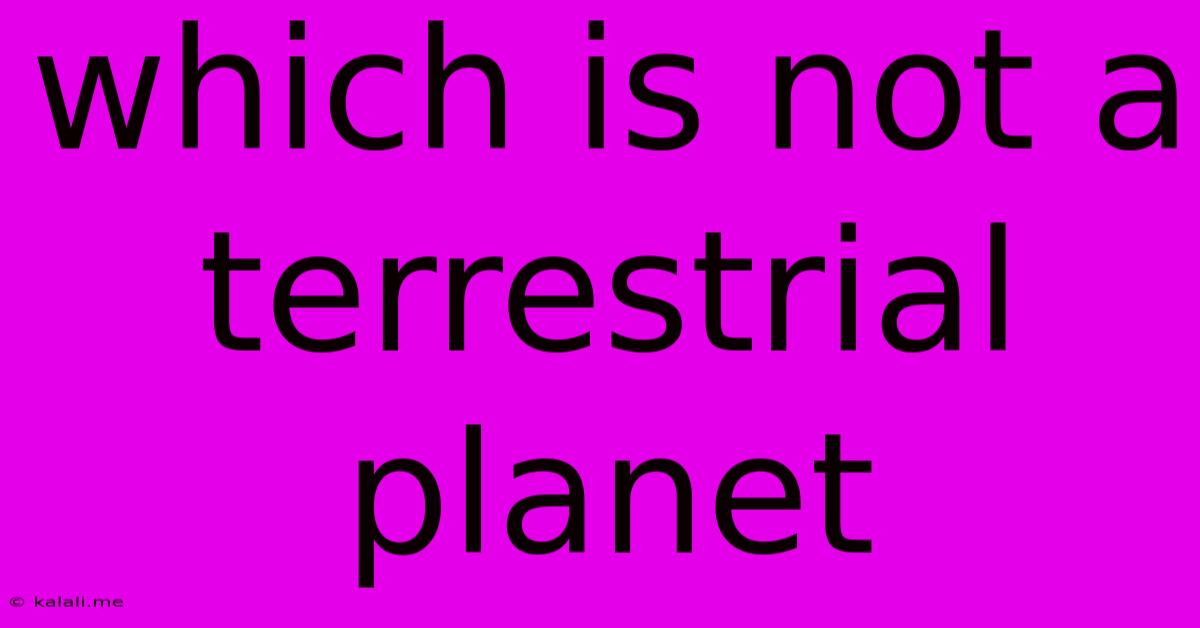Which Is Not A Terrestrial Planet
Kalali
Jun 13, 2025 · 2 min read

Table of Contents
Which is Not a Terrestrial Planet? Unveiling the Secrets of Our Solar System
This article delves into the fascinating world of our solar system, specifically focusing on the terrestrial planets. We'll explore their defining characteristics and identify which celestial body from a given list doesn't belong to this exclusive club. Understanding the differences between terrestrial and other types of planets is key to comprehending the vast diversity within our cosmic neighborhood. This guide provides a clear explanation, perfect for students, astronomy enthusiasts, or anyone curious about the planets.
What are Terrestrial Planets?
Terrestrial planets, also known as inner, rocky planets, are characterized by their solid, rocky surfaces. Unlike gas giants, they are primarily composed of silicate rocks and metals. Key features that define a terrestrial planet include:
- Solid surface: A hard, rocky exterior, unlike the gaseous atmospheres of gas giants.
- High density: Relatively high density compared to gas giants due to their composition.
- Smaller size: Generally smaller in diameter and mass compared to gas giants.
- Few or no moons: Terrestrial planets typically have fewer moons, or in some cases, none at all, compared to gas giants.
- Thin atmosphere (or none): While some terrestrial planets possess atmospheres, they are significantly thinner than those of gas giants.
The Terrestrial Planets of Our Solar System
Our solar system boasts four terrestrial planets:
- Mercury: The smallest and closest planet to the Sun.
- Venus: Known for its extremely hot surface temperature and dense atmosphere.
- Earth: Our home, teeming with life and possessing a diverse range of ecosystems.
- Mars: Often referred to as the "Red Planet" due to its iron oxide-rich surface.
Identifying the Non-Terrestrial Planet
Now, let's address the core question: which of the following is not a terrestrial planet? The answer will depend on the list provided. However, the principle remains the same. Any planet that lacks the characteristics described above – a solid, rocky surface, high density, relatively small size, few or no moons, and a thin atmosphere – would be classified as non-terrestrial.
For example, if presented with a list including Jupiter, Saturn, Uranus, and Neptune, all of these would be correctly identified as non-terrestrial planets because they are gas giants. Their compositions are primarily hydrogen and helium, lacking the solid rocky surfaces characteristic of terrestrial planets. They are also significantly larger and possess numerous moons.
Beyond Terrestrial Planets: Gas Giants and Ice Giants
Our solar system is home to more than just terrestrial planets. We also have:
- Gas giants: Large planets composed mainly of hydrogen and helium, with thick atmospheres and numerous moons (Jupiter and Saturn).
- Ice giants: Planets composed primarily of heavier elements like water, methane, and ammonia (Uranus and Neptune).
Understanding the different classifications of planets allows for a deeper appreciation of the vast diversity and complexity of our solar system and beyond. By understanding the defining features of terrestrial planets, we can easily differentiate them from other types of planets in our cosmic neighborhood.
Latest Posts
Latest Posts
-
Tides Are Caused By The Gravitational Pull Of The
Jun 14, 2025
-
Which Of The Following Is True About Ecosystems
Jun 14, 2025
-
What Act Score Is Needed For Ole Miss
Jun 14, 2025
-
Emile Durkheim Classified Suicide Into Four Types The Types Were
Jun 14, 2025
-
Substance That Increases The Rate Of A Chemical Reaction
Jun 14, 2025
Related Post
Thank you for visiting our website which covers about Which Is Not A Terrestrial Planet . We hope the information provided has been useful to you. Feel free to contact us if you have any questions or need further assistance. See you next time and don't miss to bookmark.